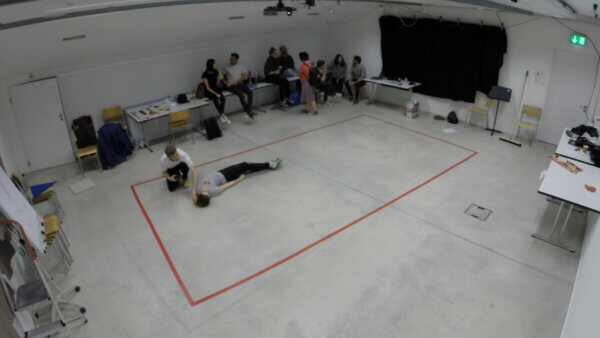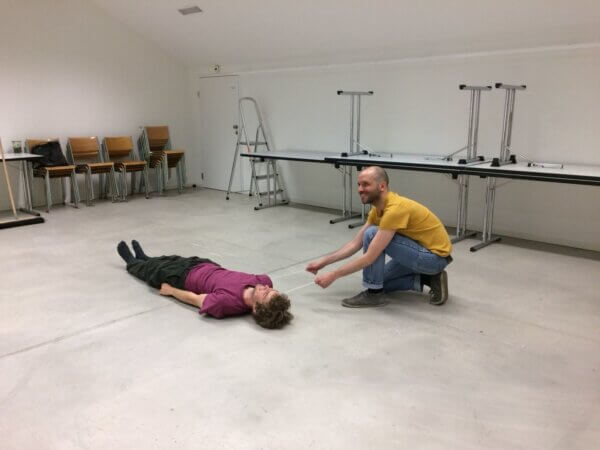Q&A with William Crook (‘Getting Started’)
Presently based in Zürich where he alternates between filmmaking, freelance commissions and teaching, William Crook kicked off his animation career in London following his studies at Kingston University and Chelsea Institute of Art and Design.
Following a run of festival screenings including the Encounters Short Film Festival, Fantoche, Mecal Barcelona, Oberhausen and our own Skwigly Screening at the Manchester Animation Festival, William’s recent film Getting Started, made to commemorate the GSFA (Swiss Animation)‘s 50th anniversary, is now available online. Combining pixilation with a keen sense of timing, fluidity and observation, the film ingeniously portrays the morning rituals that kick us into gear using a team of performers posed frame-by-frame. Skwigly spoke with William to learn more about his work, creative process and how the film came together.
Can you tell us a bit about your background, your earlier years working in London, and what ultimately brought you to Zürich?
Sure – my name is William, I enjoy twisting my body into new positions, and I’m a freelance animator who also teaches part time.
I was born in London so after I graduated from Kingston University in 2008 it made sense to move back there. A small group of us formed a collective living and working together on all sorts in an old shop basement, which was fun but not sustainable. After two years of that I took a trip to Shanghai to make visuals for a musician friend, almost accidentally found work making special effects for a bizarre kids show which kept me there a while, and met a woman who led me to where I am now, Zürich.
Have you found the change of location has had any notable effect on your work and process?
We moved with a baby and I didn’t know anybody here so I took a full time job for a while, but otherwise I carried on doing what I’ve always done – reaching out to people whose work I liked and getting involved with more interesting projects like that. Animators everywhere are generally such a friendly group of people.
Your body of work incorporates a lot of different approaches to moving image – are there any areas or methods that you find yourself particularly enamoured of?
Replacement animation, using found objects, mixing different techniques. Anything with a lot of flashing colours and shapes gets my monkey brain excited, and when it’s placed into a film that gives it a wider meaning, even better.
I’ve also been getting more and more into dance in the last few years. I think there’s a lot of overlap there, it’s definitely had an effect on what I’m doing.
Your recent film Getting Started centres around a very deft use of pixilation – is this your first project to use this or had you experimented with it previously?
The first time tried it out on this scale was with my students at the Zürich University of The Arts – I had half a day to introduce them to each other and all the stop motion equipment and came up with this.
The camera’s hooked up to a projector so you can see yourself life-size on a nearby wall, and you can take photos as you’re lying with a remote keypad – it’s so much fun. Once the students were finished I stayed behind and played around with it till the next morning.
Were there any particular pixilation/stop-motion (or other) influences in your mind when it came to making this film?
Norman McLaren for sure, Juan Pablo Zaramella too, I saw him give a really nice talk in Stuttgart and his playfulness stuck with me. Also two Swiss friends, Rafael Sommerhalder and Andrea Schneider. They helped me with the shoot and both do their own super inventive stop motion stuff, if you like that kind of thing you should check them out
Was this a funded/commissioned project or an independent film?
It was commissioned by the GSFA (The Swiss Animation Association) to celebrate their 50th anniversary – all those people you see under the camera are animators!
It featured in an omnibus made for the occasion, you can see the whole thing here.
Where did the initial germ of the idea come from?
After those experiments I knew I wanted to do something with pixelation, flickering people, and having them thrown around by an invisible force, and that was all rattling around in my head when the GSFA was asking for ideas.
The success of the film as a viewing experience seems alternately rooted in keen observation, precision timing and an appealing fluidity to the motion. Were you able to get these results on the fly or was there any pre-visualisation in building the film?
Thanks! It was a mix – after a lot of stop motion tests I pre-animated some sections in After Effects and that worked great for the big stiff movements, but when things got more fluid or subtle it was easier to twist my body around and figure out what looked good under the camera.
Did working with actual performers generate any unanticipated challenges or issues along the way?
If I were to do it again I would try get a masseuse involved – It turns out lying still on a concrete floor for 8 hours makes everything hurt. We stuck some padding to my bony bits and Rafael improvised a person-sliding-device which helped.
The other people were all animators so everything clicked very quickly. We didn’t have long to shoot but everyone was very polite and let me push and pull them around as needed. Except the children, who were just rolling all over the place.
Roughly how long did the shoot itself take?
I was making tests for about two months, on and off, but everything in the final film was shot over 4 days – it was as long as I could get the space for.
After you’d captured everything did you further edit the film and add sound or had the timing all been worked out in pre-production?
A big chunk of the timing had been worked out beforehand, about 70%, but there was no time pressure after the shoot so I ended up playing around with the edit for another month or two, going back and forth with the musician and tweaking the dancey section.
Outside of this film can you tell us a bit about the other work you do in animation?
Outside of my own experiments I’ve been doing all sorts, I like the variety: some segments for documentary, character animation for a museum, an explainer film for a charity, helping out with some artistic projects. I also enjoy teaching, students and clients kind of balance each other out nicely.
Your commissioned work is complemented by a great deal of personal experimentations – is this an important part of developing yourself as an artist?
Sure, it’s also just a way of keeping happy, I get fidgety if I haven’t made something for myself in a while. I like to get something out without having to commit to a huge project, and it’s satisfying to see this little catalogue of ideas growing.
What other projects do you have on the horizon that you can discuss?
I have some nice small commissions to keep me busy, another dance/animation adjacent idea which I’m figuring out, I just found an interesting space in a basement I’d like to do something with, and I’m trying to make a perfect smoked salmon sandwich – horseradish, red onion, capers, little bit of lemon. If you have any tips please send them to will.crook@gmail.com
See more of Will Crook’s work at williamjcrook.com



